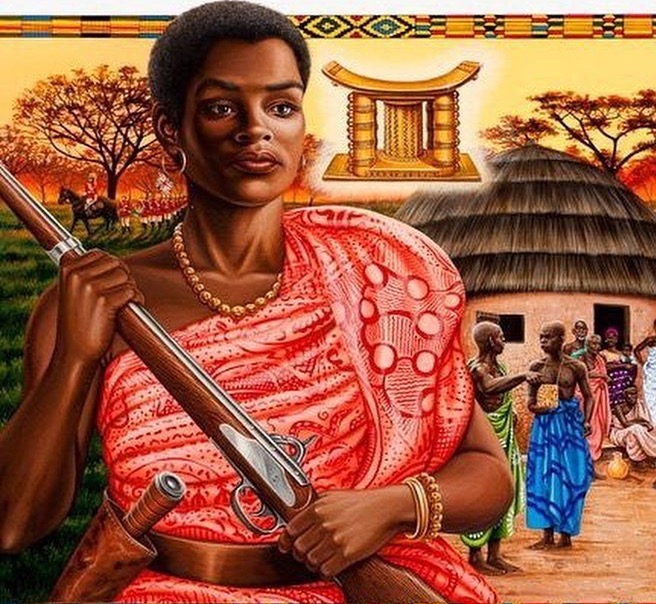
All over the world, there have been records of powerful women breaking barriers, leading wars, riots, invasions, and setting records throughout history. When it comes to Africa, the continent’s history will be incomplete without the contributions of some powerful women. These women accomplished incredible feats, from commanding armies to defending human rights among others.
Aside from the events recorded by colonialists, there isn’t much knowledge on potential icons who existed before the colonial period. Many African regions had inadequate record keeping procedures, and knowledge was mostly passed down through generations by word of mouth.
Despite this, we continue to honor the powerful women whose illustrious achievements we frequently hear about and about whom we have written. It is important because, in today’s world, where more Black women are breaking the bias in different areas of life, it’s critical to remember the historical women who set the standard for Black female excellence.
The stories of these remarkable women will inspire modern African women who aspire to greatness and those who have already achieved greatness and are striving for more.
The Warriors
These are prominent powerful women who led and won wars. Their historical significance cannot be overstated, as it was through their bravery that several African colonies have survived to this day.
Queen Amina of Zaria
Queen Amina, a prominent female figure in Nigeria’s northern region, is the first African woman to ascend to “Sarauniya” (queen) in a pre-colonialized male-dominated society. Her evident military prowess propelled her to prominence, earning her the title “warrior queen.”
She ruled for 34 years, expanding her influence and gaining control of all surrounding lands. She is responsible for unifying the lands that constitute modern-day Hausaland in Nigeria. This was possible as her military was formidable and feared by many, ensuring her reign to be mostly free of wars. Her military was notable for using unique innovations such as metal armor like iron helmets and chain mails, crafted by the best metal workers in the land.
Queen Amina is regarded as a significant female African icon because she was a supreme leader who symbolized female strength.
Ana Nzinga, Queen of Ndongo
Queen Nzinga ruled the Ndongo people when the Portuguese attempted to establish a colony in Luanda (modern-day Angola) and its surrounding areas. While other authorities in the region struggled to deal with the situation, Nzinga rose to the occasion. She allied with the Portuguese, which strengthened her in the war against her African foes and stopped them from enslaving her people.
The Portuguese eventually betrayed her and invaded Ndongo. This invasion forced her to retreat to Matamba. This time, she collaborated with the Netherlands and instigated a rebellion in Ndongo.
Despite this, she was not strong enough to drive the Portuguese out of Luanda. She then concentrated on establishing her stronghold in Matamba, forming a powerful army, and leveraging her territory’s geographical advantage to become a central trading power. Queen Ana Nzinga is regarded as a diplomatic leader and skilled negotiator since her wisdom and diplomacy aided in consolidating those old lands into the modern Angola that we know today.
Queen Taytu Betul
Queen Taytu, who is known as the founder of Ethiopia’s capital, Addis Ababa, ruled Ethiopia with her husband, Emperor Menelik II. Their union was a political one, and she refused to be relegated to the role of emperor’s wife. She was regarded as an equal to her husband and often took stronger stands on political issues.
The battle of Adwa, which was fought primarily to prevent the Italians from taking over their territory, is her most notable achievement. Queen Taytu is believed to have led 5,000 infantry and 600 cavalry warriors to the fight. She met her fate when she shut off the Italians’ water supply at a fort they constructed in Mekelle.
Her ability to read and write was one of her key strengths. She was a brilliant political figure as well as a fearless military commander.
Yaa Asantewaa
Yaa was a farmer before her elder brother took up a traditional title and crowned her “Queen Mother.” The guarding of the Golden Stool was one of her queen mother’s responsibilities. In the Ashanti Kingdom, the Golden Stool was a powerful emblem revered by all. In an attempt to hijack the Stool, the British captured the King, Yaa Asantewaa’s grandson, and other powerful Ashanti leaders, exiling them to the Seychelles island. Yaa Asantewaa rallied her troops and marched out to battle the British. As a result, she was promoted as Commander in Chief of the Ashanti Army.
However, this was not the last time the Ashanti and the British fought. There were four more conflicts, the last of which was the bloodiest.
The final war began when British commander, Frederick Mitchell Hodgson, sat on the Golden Stool. It was inevitable, as the Golden Stool was a respected symbol. Yaa Asantewaa, enraged, challenged the men who refused to fight. She told them that if they didn’t fight, the women would. These words not only spurred them but also disputed traditional gender roles.
Yaa was captured and exiled to Seychelles during the war, where she died in 1921. She became, and continues to be, a symbol of resistance and strength for her people.
The Dahomey Amazons
Tassi Hangbe, the daughter of King Houegbadja, who founded the Dahomey kingdom, created the Dahomey Amazons. These powerful women warriors are recognized as the fiercest set of warriors in the history of Dahomey (modern-day Benin republic). She was crowned queen after her twin brother died, and she returned from a military mission.
The Dahomey Amazons were created to push more powerful women to participate in traditionally male-dominated activities such as farming and hunting.
She then began recruiting very young girls and providing them with sound military training at a young age. This act gave birth to some of the most feared female warriors in history. These women were so fearless that they slew any hurdle in their path, no matter how terrifying it appeared.
When they finally fought the French, who were more armed than they were, they suffered heavy losses. Regardless, they continue to be viewed as feminine empowerment and strength symbols. (Read about the Amazones women master drummers)
The Activists
These are women who battled for their people’s rights and liberation. They made significant sacrifices as a result of their various actions.
Queen Moremi of Ile-Ife
Queen Moremi was married to Oranmiyan, the heir to the monarch of Ile-Ife when the people of Ile-Ife were attacked by the Igbo (meaning forest, not the main Igbo tribe) people. She went to Esimirin, the water deity, and promised to make the greatest sacrifice if she could just figure out her enemies’ secret and save her people from destruction.
The water spirits fulfilled her desire because she discovered their secrets after willingly allowing herself to be caught by them, gaining their trust, and even marrying their king as “anointed queen.”
When she discovered their secret, she escaped and returned to her homeland to inform her troops. They destroyed their enemies, but it was finally time for her to fulfill her pledge to the river spirits, who had demanded her son, Olurogbo’s, life. She couldn’t refrain from doing it for fear of provoking their wrath, which brought great sorrow in the land.
Moremi’s tale is one of love, commitment, and sacrifice, which is admirable since it takes a lot of bravery to make the greatest sacrifice.
Queen Nanny of the Maroons
Although she is a Jamaican national hero, her roots are in Africa, specifically Ghana. She was an Obeah woman (a person who practices deep African spiritual rites) and a Maroon leader. The Maroons were formerly enslaved people who escaped and formed their settlements.
Nanny and her four brothers were sold as enslaved people, but they escaped and became leaders of their settlements. Nanny Town was the name of the community she led with her brother. It was erected in the Blue Mountains in the eastern region of Jamaica. Because the Europeans couldn’t invade due to its geographical location (mountains surrounded it), this village thrived in trade and farming. Nanny avoided invading plantations, despite orchestrating raids that freed over a thousand enslaved people.
The success of the Maroons put the British in jeopardy, as they were losing enslaved people and resources. Nanny was killed in 1733, while her town was destroyed in 1734 during a battle that lasted almost twenty years.
Jamaicans still revere Queen Nanny, and one can find her portrait on the country’s $500 note.
The Aba Women
The Aba women’s riot began in Nigeria in November 1929 and is considered one of the greatest rebellions. Over 10,000 women from six Nigerian tribes participated in the movement. These tribes are Igbo, Ogoni, Ibibio, Opobo, Andoni, and Bonny.
This revolution began when the British imposed a tax on everyone in the land, including women. According to the tax law, households were to be taxed based on the number of persons who lived there, including livestock. The taxes were then modified according to these specifications: the higher the count, the higher the tax.
The issue emerged when women were required to pay taxes as well. Normally, Igbo tradition prohibits women from paying taxes. Therefore, this provoked an uproar that resulted in a riot. The women revolted against the imposition of taxes and the removal of a tyrannical warrant chief. Fifty-one women and one man died as a result of the riot.
Finally, the British withdrew the taxation and curtailed the power of the warrant chiefs. Things improved as women gained respect in those areas, and some powerful women were even appointed as warrant chiefs.
The Aba Women’s Riot is a movement that will live on in African history because it demonstrated the power of numbers and women working together to overcome obstacles.
These stories demonstrate how African women have broken biases and fought for their rights and the rights of their people throughout history. These stories should inspire you as a modern African woman, as these women’s strength, resilience, and bravery are worthy of emulation.






